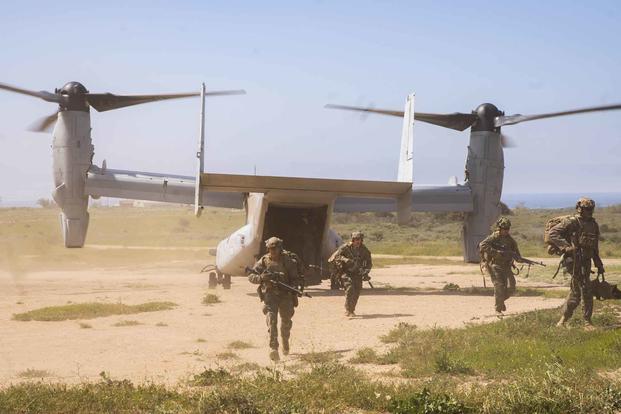
The Air Force is still not flying Osprey aircraft in Japan despite getting the green light to lift a monthslong flight hold following a deadly crash off the country’s southern coast, but the Marine Corps has put its aircraft based there back in the skies.
Rebecca Heyse, an Air Force Special Operations Command spokeswoman, told Military.com on Tuesday that none of the service’s units have resumed flying the Osprey yet.
In contrast, the Marine Corps’ 1st Marine Aircraft Wing, which is based in Okinawa, quickly moved to fly its MV-22s, announcing a return to flight status on March 14 — less than a week after the hold was lifted, according to a statement released the same day.
Read Next: Coast Guard Boats, Aircraft Search for Victims of Massive Bridge Collapse in Baltimore
The aircraft — which is flown by the Marine Corps, Navy and Air Force — was allowed to return to flight in early March after Naval Air Systems Command and the V-22 Joint Program Office announced that they had discovered a new and not fully understood mechanical failure as part of the investigation into the Nov. 29 Air Force Osprey crash off the coast of Yakushima Island that left eight airmen dead.
The Navy doesn’t have any Ospreys permanently stationed in Japan. A Navy spokesperson told Military.com on Tuesday that its CMV-22Bs based in San Diego, California, have begun the process of returning to flight.
Officials who allowed the aircraft to return to flight argued that data analysis led to the decision to deem the Osprey safe — while refusing to disclose any information about what part failed or any major details on procedural changes that were made as part of the grounding being lifted.
“We have high confidence that we understand what component failed, and how it failed,” Marine Col. Brian Taylor, the V-22 program manager, told reporters in a briefing in early March.
“I think what we are still working on is the ‘why,'” Taylor said, noting that “this is the first time that we’ve seen this particular component fail in this way.”
The Air Force’s more cautious approach evokes parallels to how the public discovered the other yet-to-be resolved issue with the aircraft in 2022.
In August 2022, the Air Force briefly grounded its fleet of Ospreys after they experienced a series of hard clutch engagements that worried leaders in the service.
However, the very next day, the Marine Corps said not only that its Ospreys would keep flying but that its pilots could handle the issue, which it has known about for years.
The hard clutch problem is an issue with the Osprey’s complex system of clutch assemblies that are supposed to enable one engine to fly the aircraft in the event of an engine failure. However, in some instances — at least 15 mishaps — those clutches have failed.
Military.com reported one such mishap with an Air Force Osprey that could have become fatal in 2017.
Despite assurances from the Marine Corps that the problem was under control, the clutch issue became deadly in June 2022 when one of its Ospreys crashed in the California desert, killing five Marines.
After that incident was investigated, Taylor also argued that data analysis of some of the more recent incidents involving the clutch led his office to conclude that replacing a critical component — the input quill assembly — more frequently was 99% effective despite skepticism from a Marine Corps widow of one of the pilots.
Now, the Marine Corps is again saying it has utmost confidence in the aircraft.
“The flight clearance by our NAVAIR, our adherence to proven operational risk management practices, our confidence in this amazing aircraft, and our faith in the professionalism of our pilots, crew and maintenance teams undergird our decision to return the Osprey to service,” the 1st MAW said in its statement.
The Marine Corps is also very dependent on the Osprey. It owns nearly 350 aircraft, compared to the Air Force’s roughly 50 airframes.
Lt. Gen. Karsten Heckl said in February that the Corps has seen “dramatic impacts” from the flying halt, while 1st MAW’s commander, Maj. Gen. Eric Austin, said the Osprey is “key to the success” of his unit.
In the March statement, Austin said the Osprey “plays a central role in our ability to campaign, to respond in time of crisis, and ultimately to partner with our allies and maintain a free and open Indo-Pacific.”
Japan’s Ground Self-Defense Force, which also flies the Osprey, also resumed flights last week, according to a report from Japan Times.
Related: Ospreys Cleared to Fly Again After Deadly Crash Despite Mechanical Failure with Unknown Cause






